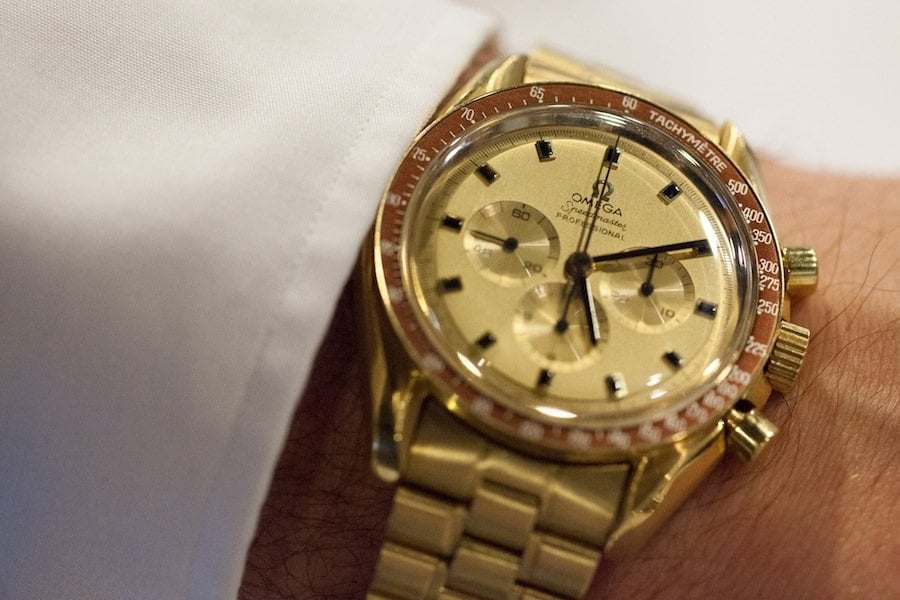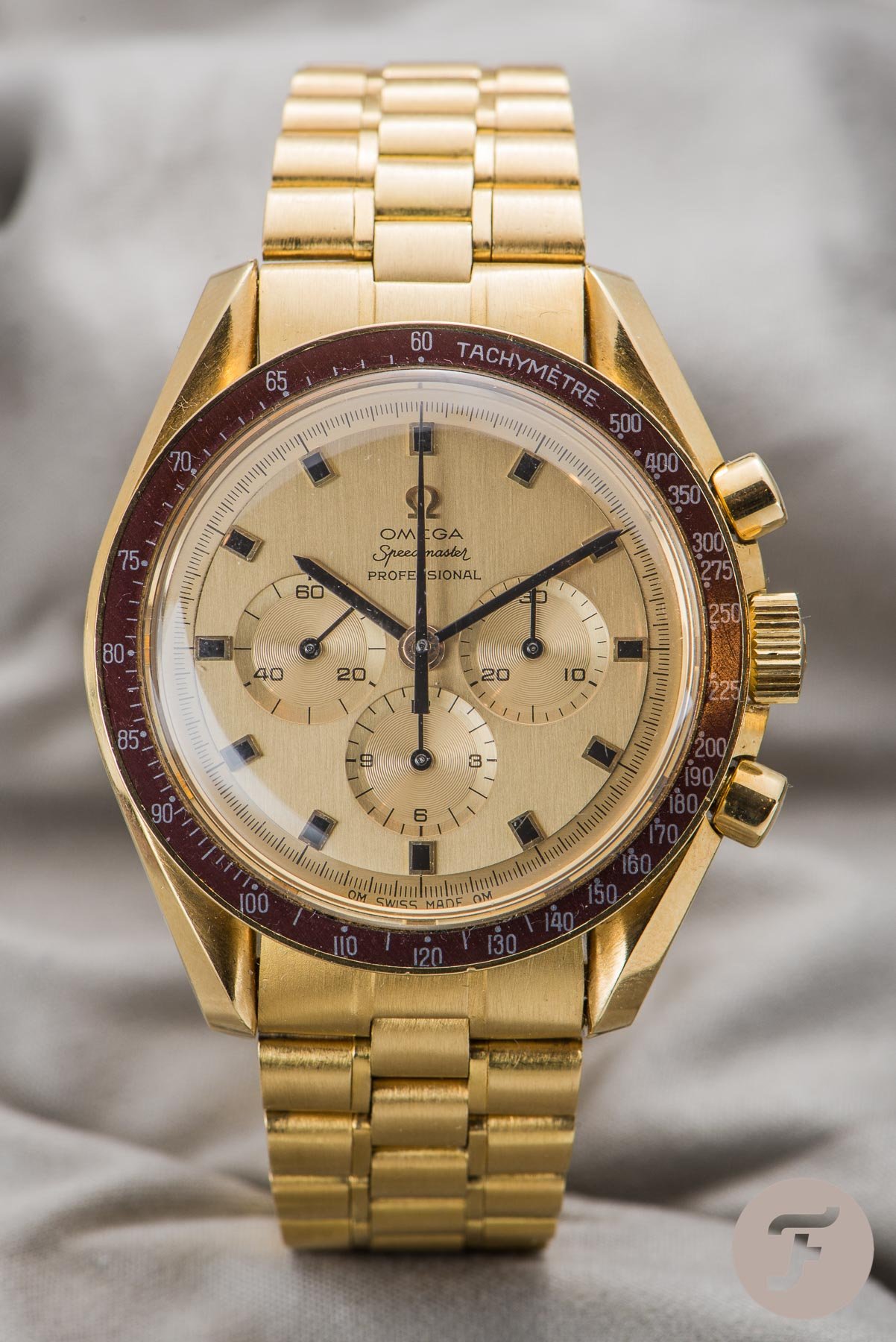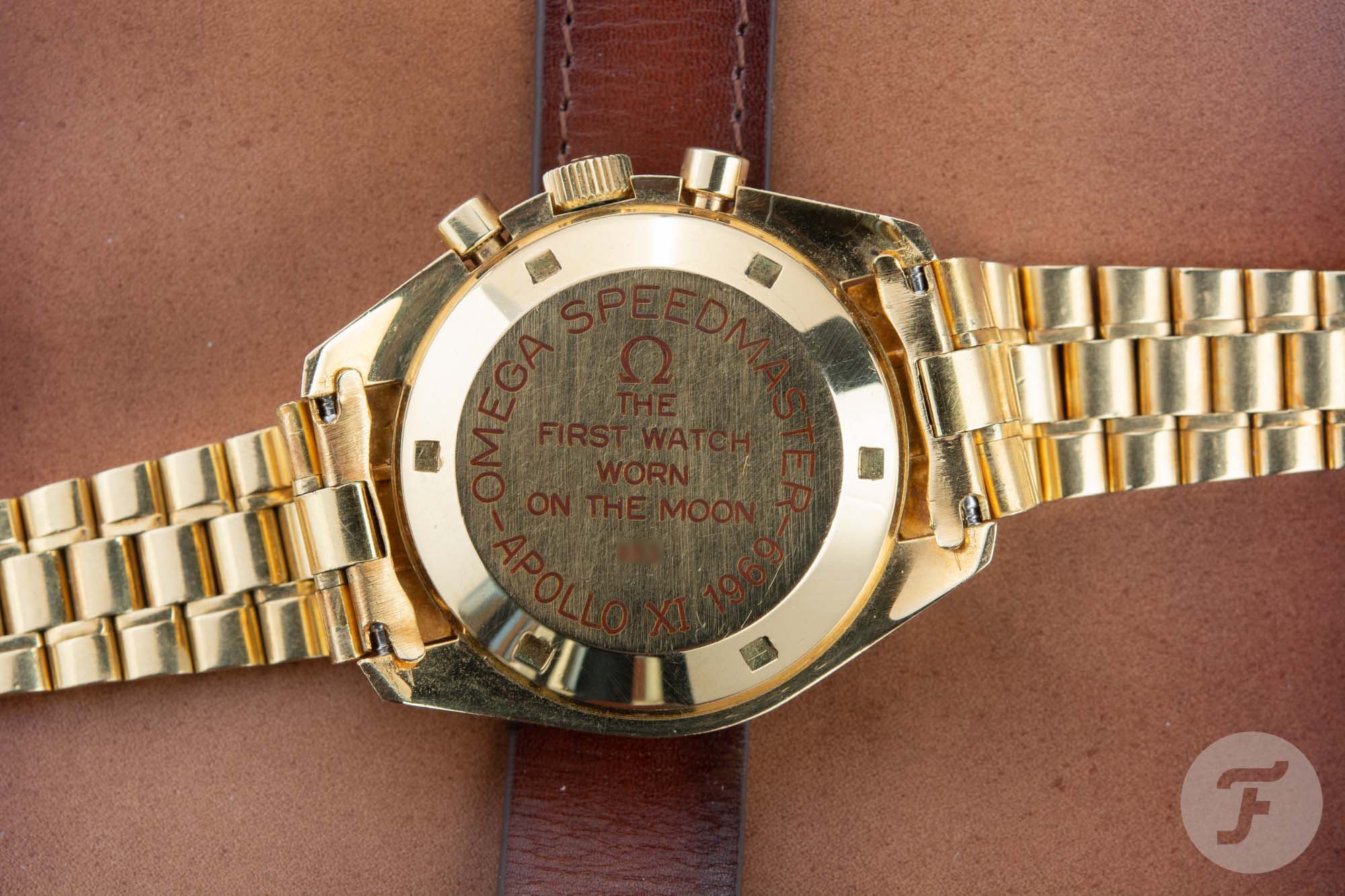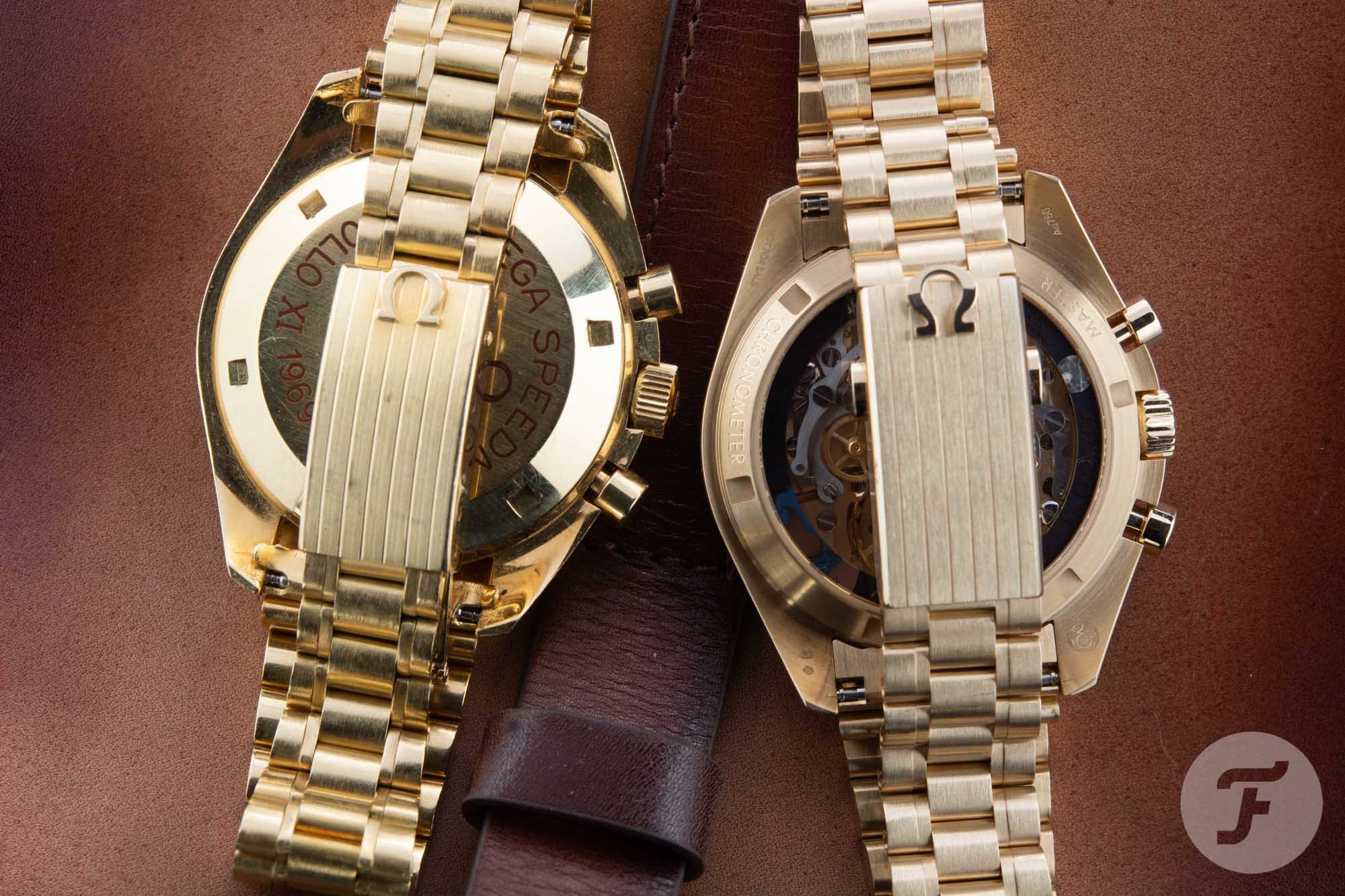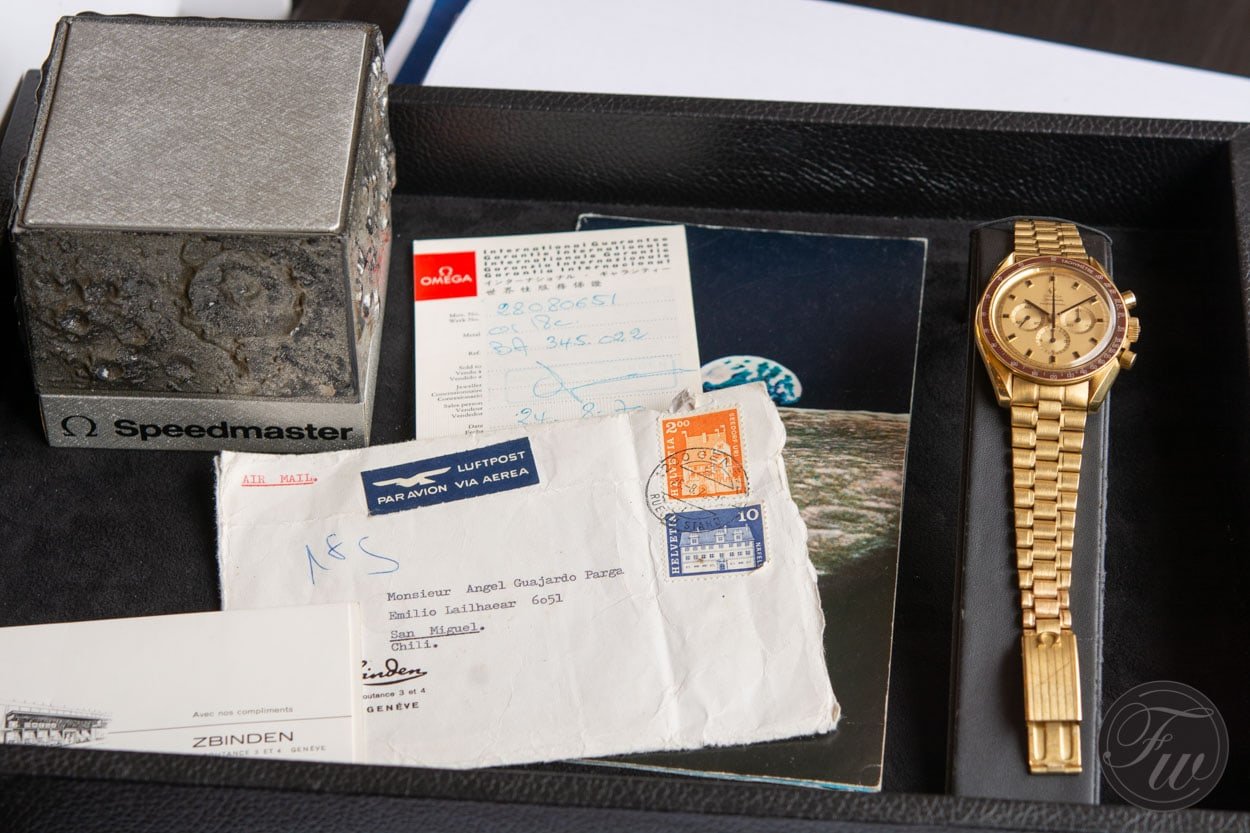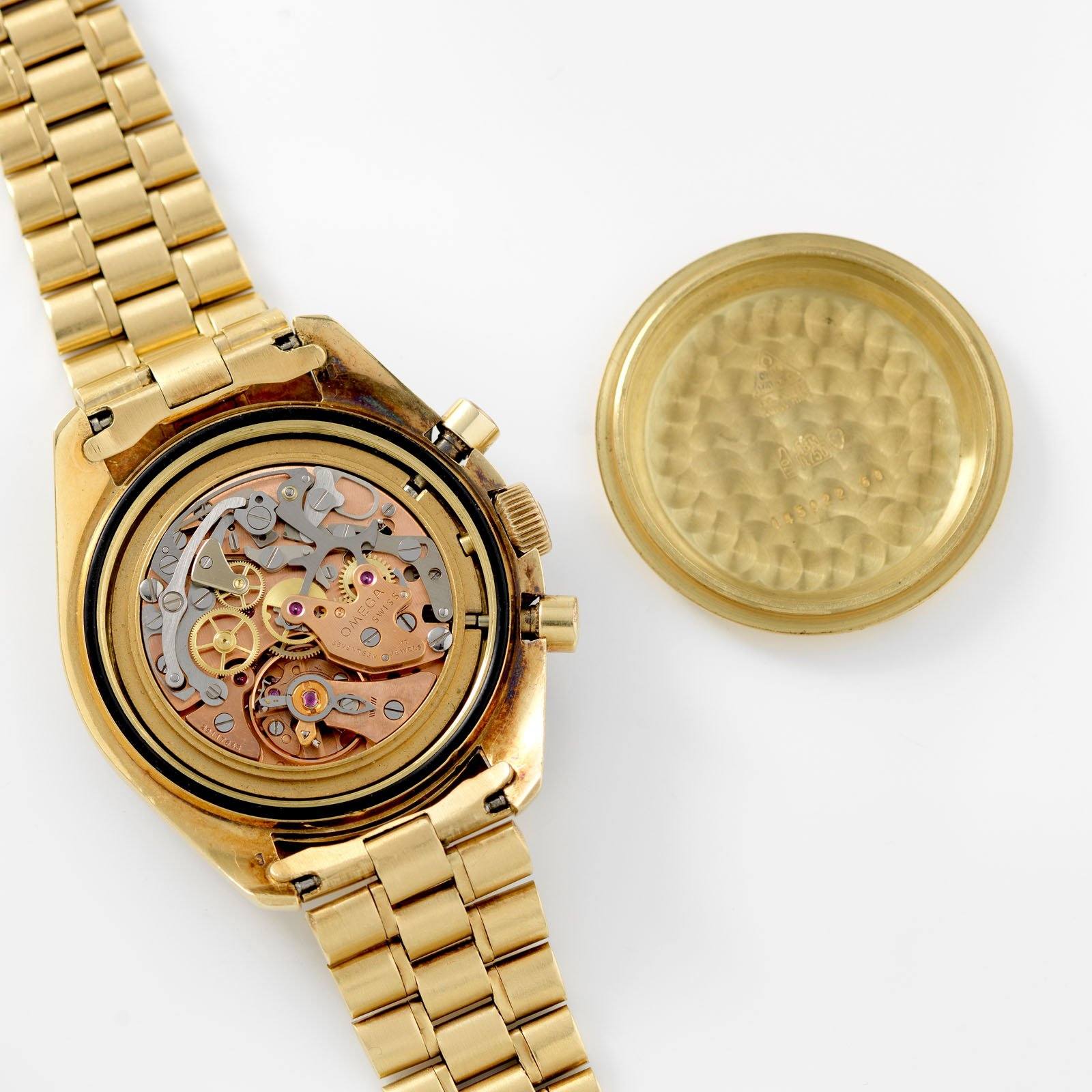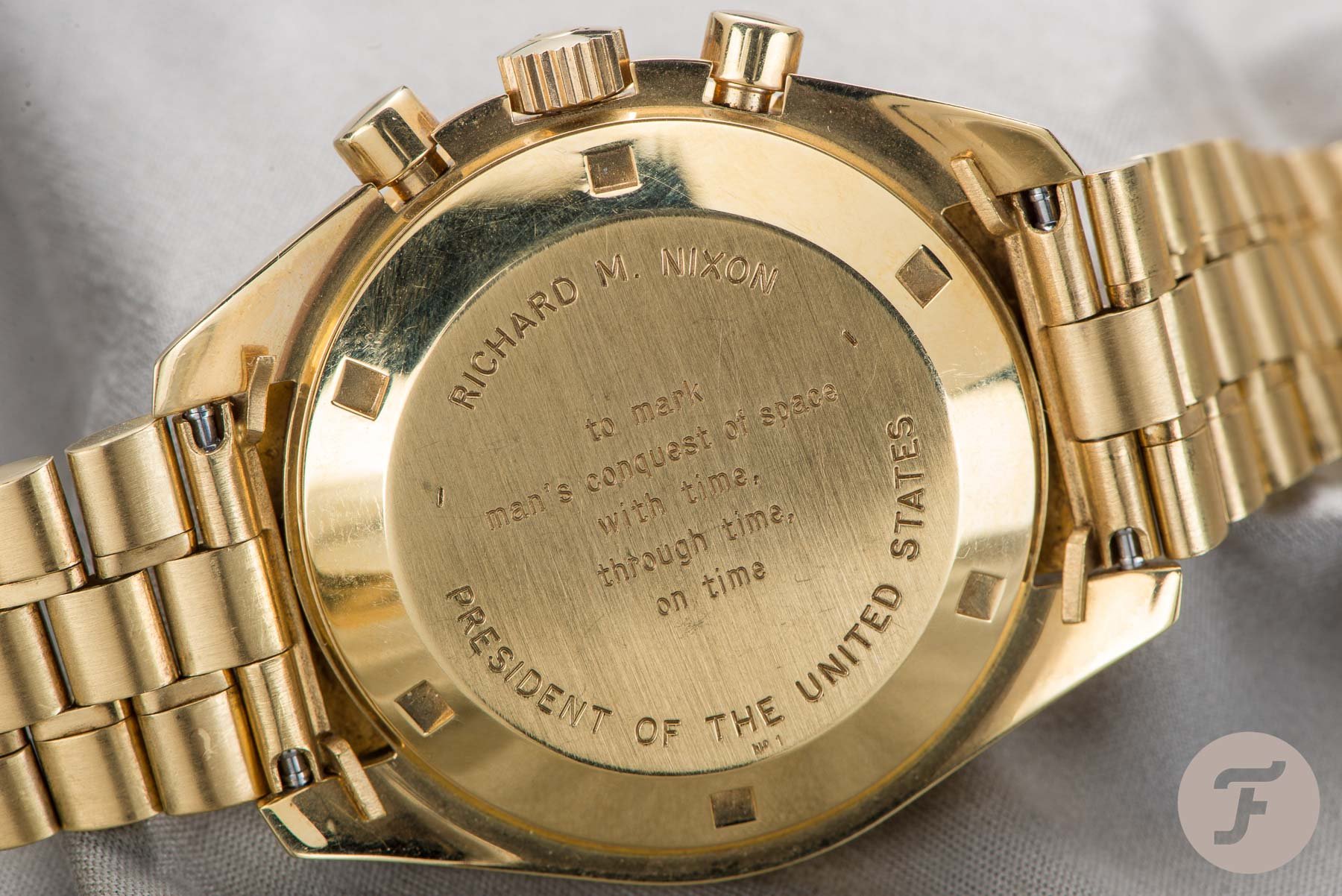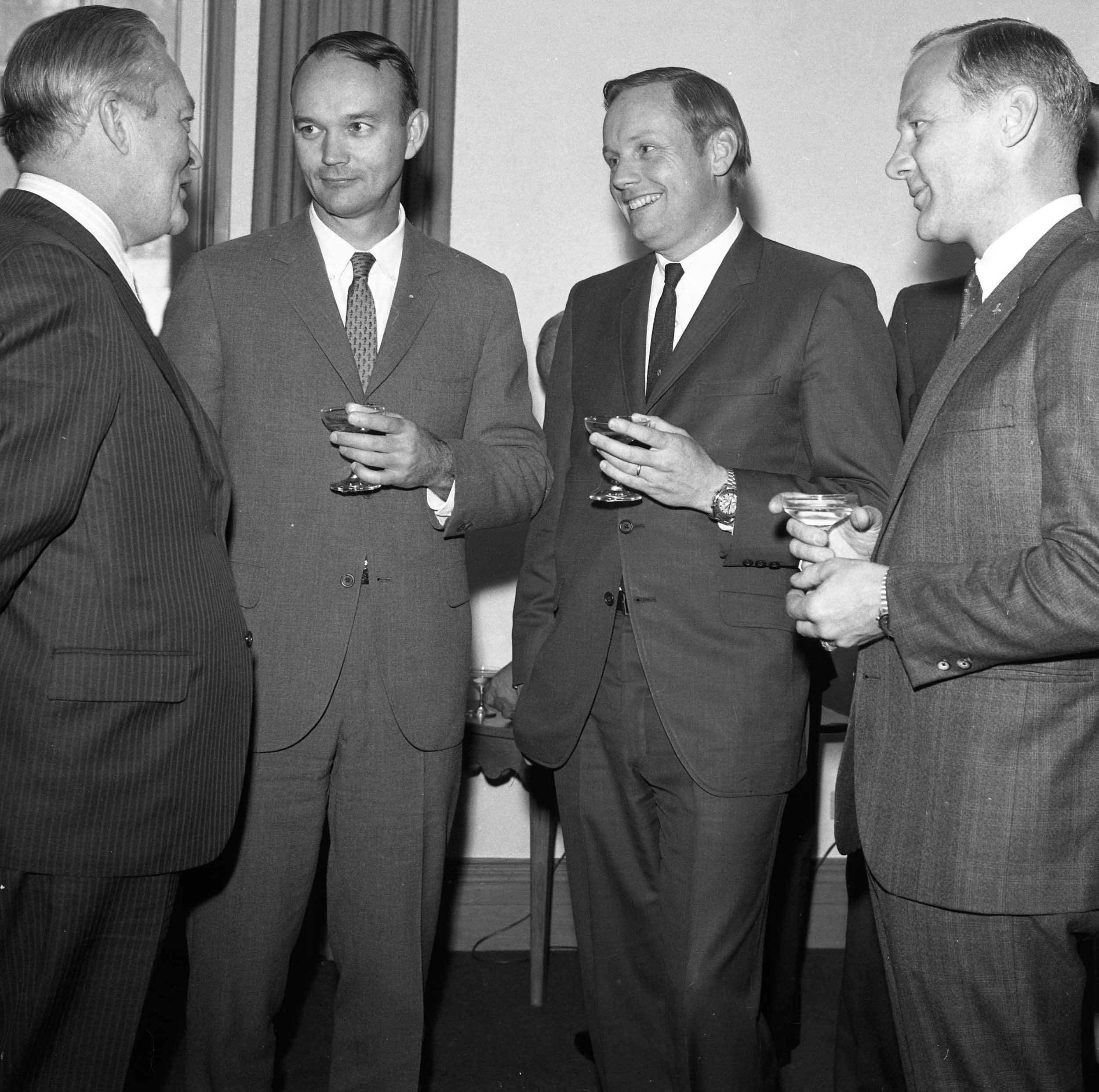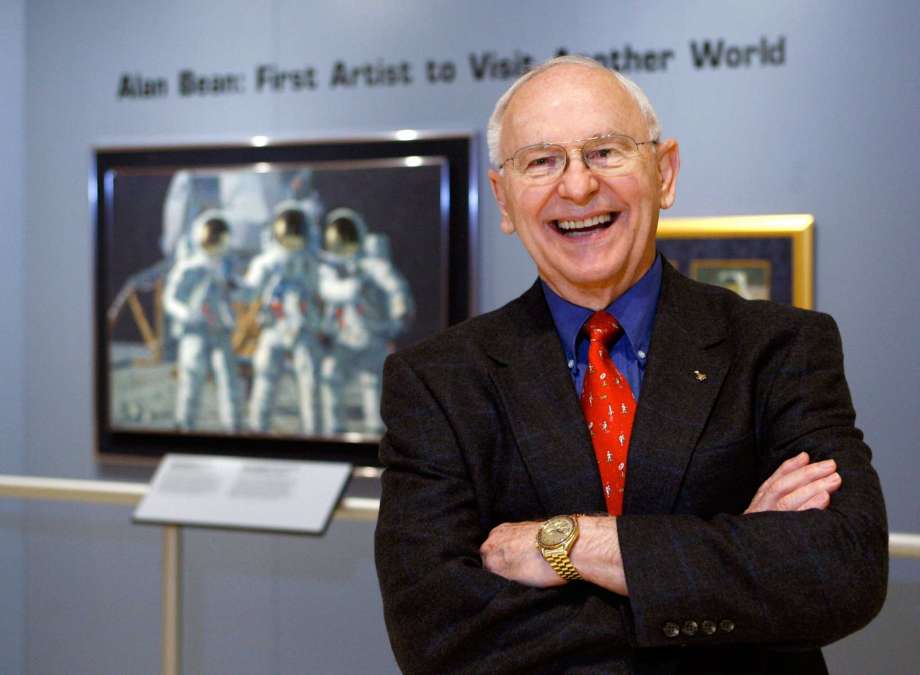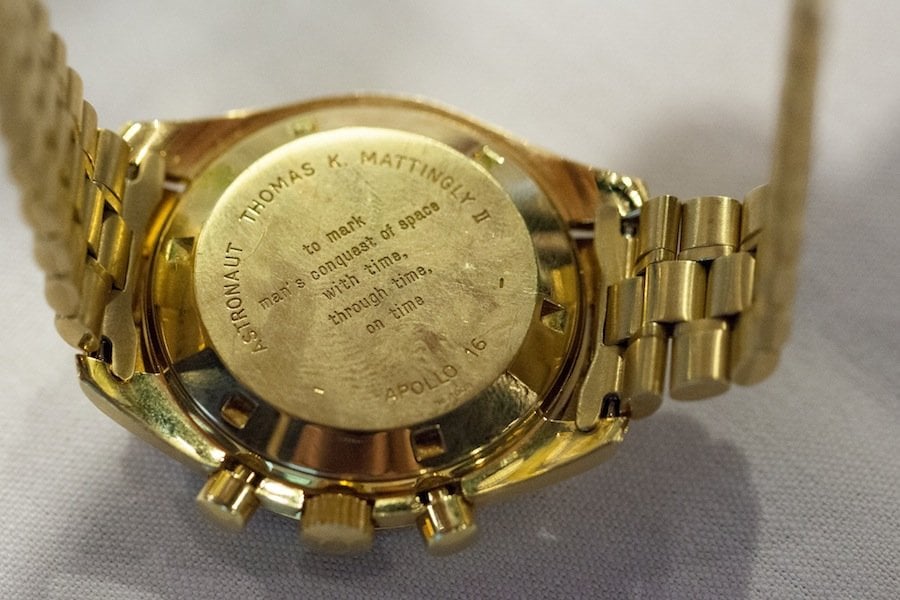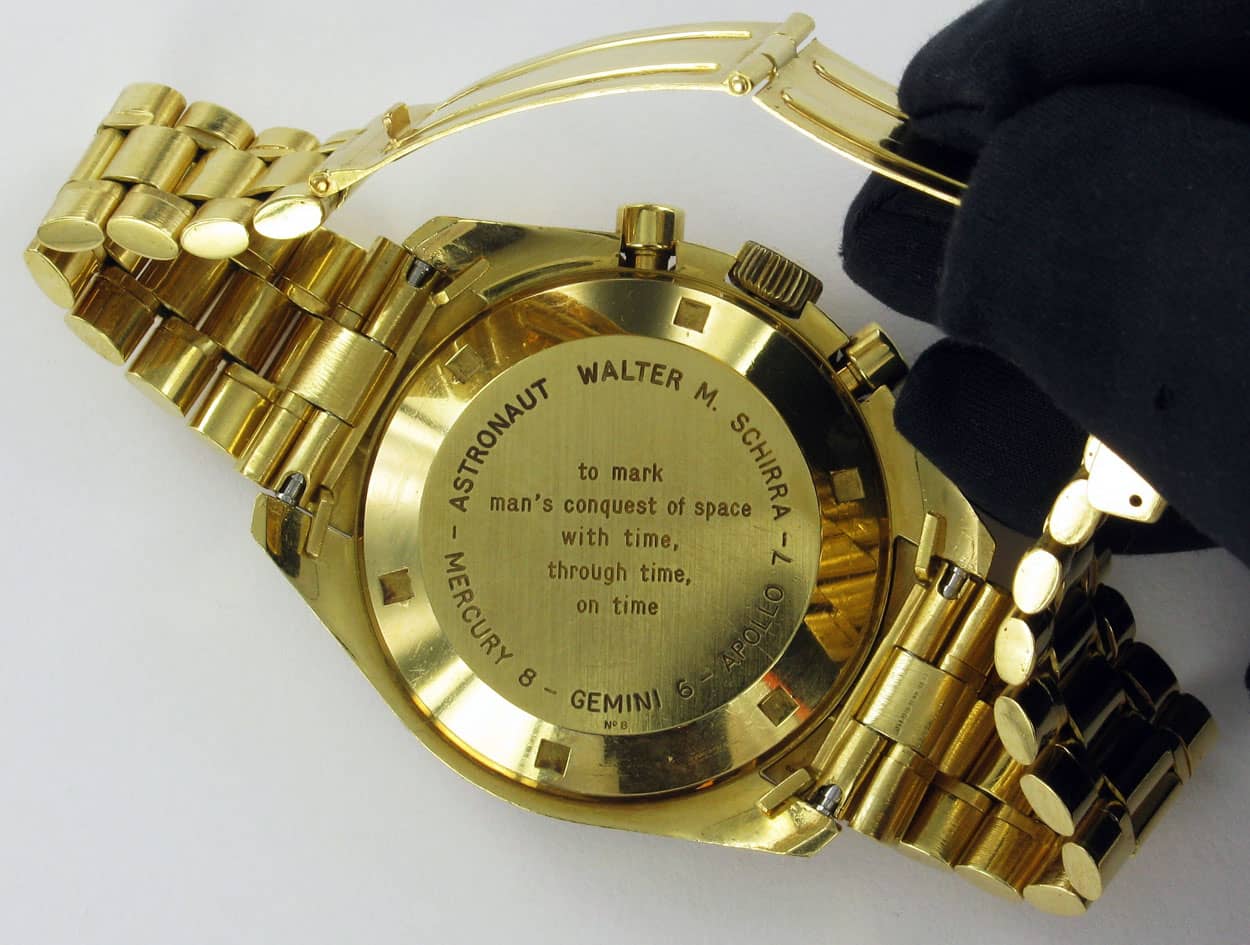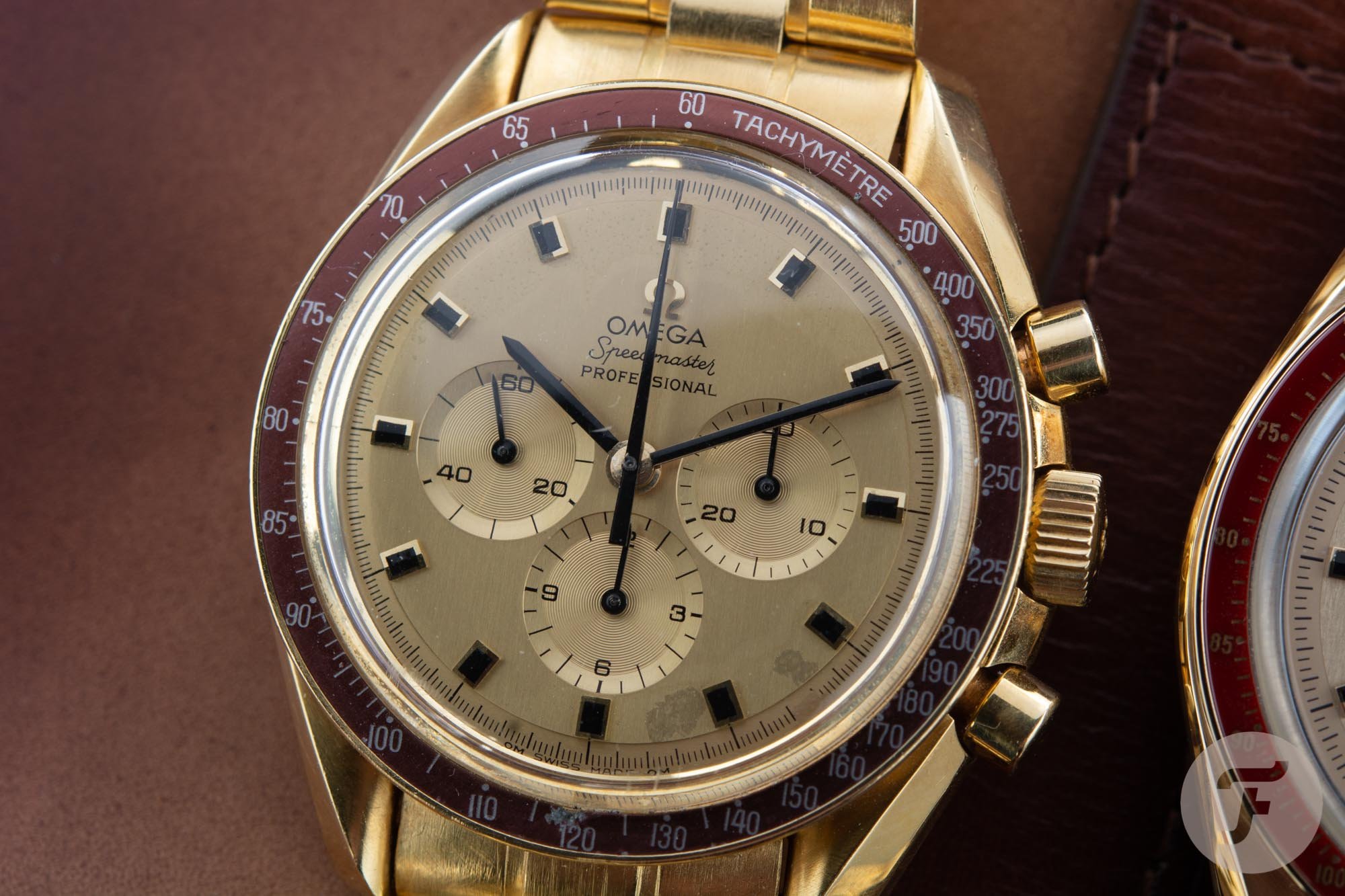The Ultimate Guide To The 1969 Omega Speedmaster Apollo 11 Gold BA145.022
This article is all about the gold Omega Speedmaster Professional Apollo 11, reference BA145.022-69. The gold commemorative watch was presented to all the active NASA astronauts in 1969, to the US President and Vice President, as well as to some other officials. It also became available to the public, with a slightly different inscription on its gold case back.
We’ve covered it very often, especially when an astronaut’s gold Speedmaster has come to the surface or when we saw an interesting example for sale or at an auction. This gold Speedmaster is also referred to as a “Tribute to Astronauts” watch. It was the first gold Speedmaster that Omega created, and it was offered to the active astronauts at a gala dinner on November 25th, 1969, at the Hotel Warwick in Houston.
The Gold Speedmaster Apollo 11 BA145.022-69
In short, the Omega Speedmaster Professional reference BA145.022-69 is a full-gold version of the then steel 145.022. It features an 18K gold case with the same design cues and dimensions as the regular steel Speedmaster Professional. The gold bezel has a burgundy red aluminum inlay, with the famous “dot over ninety.”
One of the things that makes this BA145.022-69 reference so special is, of course, the solid gold dial. This is indicated by the “OM” next to “Swiss Made”, which means “Or Massif”, or “solid gold.” The hour markers are made of onyx, have two facets each, and are set in gold frames. The hands are black with gold centers and give wonderful contrast to the solid gold dial.
The step dial comes in two different versions, the first having the oval O in Omega, like the dials of the first Omega Speedmaster CK2915 references. The second version is similar to the regular 145.022-69 dial, where the S in Speedmaster doesn’t join the P, is of average height, and is slightly open at the top. So basically, it’s a typographical change.
There are three different versions of the case back on the gold Speedmaster Apollo 11. There’s the one given to the astronauts and presented to the White House, which features a special engraving (more below), as well as two with an engraving for the watches that were for the public. These publicly sold watches had the usual Moonwatch engraving, with “OMEGA Speedmaster” and “The First Watch Worn On The Moon” accompanied by “Apollo XI 1969”. The very first watches have this engraving unpainted, while later models have this engraved painted in red, similar to the color of the bezel inlay.
1116/575 Bracelet
All watches came on a gold bracelet with hollow links (common at the time) and a small 14mm gold clasp with striping decoration. The bracelet has reference 1116 with reference 575 end-links. Omega also made this bracelet in steel, with the same numbers engraved. The brand used that bracelet for the 105.012-66, 145.012-67, 145.012-68, and the 145.022-68/-69/-71. Unlike the 1039 or 1171, also used on a number of these references, it had polished in-between links. Interestingly, while the gold 1116/575 uses the same reference as the steel version, the clasp is entirely different.
Speedmaster Apollo 11 crater box
Omega’s gold Speedmaster Apollo 11 ref. BA145.022-69 came in a crated box. It was a square box that had a 3D crater structure made of plastic on all the sides. These are tough to find separately, although I did many years ago (at least 10+ years) for a friend who owns a gold Speedmaster Professional Apollo 11 BA145.022-69. I think he paid around €500 at the time, but I’m sure it will be several times that price today.
Caliber 861
Inside the 18K gold 42mm Speedmaster Professional case ticks the Lémania based caliber 861. This movement was introduced to the reference 145.022 in 1968. It is the copper-colored chronograph caliber 861 with a steel brake (the nylon ‘Delrin’ brake came later, in 1971). This caliber 861 has a ticking speed of 21,600vph and uses 17 jewels. It is exactly the same movement that was also used in the steel Omega Speedmaster Professional reference 145.022 watches.
Let’s talk numbers
Number 1 and number 2 were reserved for President Nixon and Vice President Spiro Agnew. Both had to decline this gift due to its high value, and these first two watches ended up in the Omega Museum in Biel, where they still can be found on display.
Watches for the astronauts
Omega presented 26 of these gold commemorative Speedmaster BA145.022 watches to the astronauts (of which three were awarded to the astronauts who died during the Apollo 1 accident) at the Houston gala dinner. However, only 19 of the 26 astronauts were able to attend. Later on, in 1972 and 1973, another 8 pieces were awarded to astronauts who flew on the Apollo 14, 15, 16, and 17 missions. There’s no official record of the Apollo 13 crew receiving the watches, but we’ve been informed by Omega that they did receive the watches later as well. Jim Lovell already received his before, due to his earlier missions (his name is also included in the table below). In the picture above, you see Neil Armstrong, second from right, wearing his gold Speedmaster Apollo 11.
1014 watches in total
In total, there are 1014 pieces of this gold Speedmaster Professional BA145.022-69 produced. Numbers 3 to 28 were given to the astronauts as well as numbers 1001 to 1008. Numbers 33 to 1000 were produced for public sale. The publicly sold versions had a different case back engraving than the ones for the astronauts, the White House (numbers 1 and 2) and some other VIPs (numbers 29 to 32, which went to people from Lémania, Omega, and Raoul Kohler of the municipality of Bienne). The gold Omega Speedmaster Apollo 11 watches numbered from 1009 to 1014 were presented to other VIPs as well.
| #3 | Al Shepard | (Mercury-Redstone 3, Apollo 14) |
| #4 | Gus Grissom | (Mercury-Redstone 4, Gemini 3, Apollo 1) |
| #5 | John Glenn | (Mercury–Atlas 6, STS-95) |
| #6 | Scott Carpenter | (Mercury–Atlas 7) |
| #7 | Gordon Cooper | (Mercury-Atlas 9, Gemini 5) |
| #8 | Wally Schirra | (Mercury-Atlas 8, Gemini 6A, Apollo 7) |
| #9 | John Young | (Gemini 3, Gemini 10, Apollo 10, Apollo 16, STS-1, STS-9) |
| #10 | Ed White | (Gemini 4, Apollo 1) |
| #11 | James McDivitt | (Gemini 4, Apollo 9) |
| #12 | Pete Conrad | (Gemini 5, Gemini 11, Apollo 12, Skylab 2) |
| #13 | Thomas Stafford | (Gemini 6A, Gemini 9A, Apollo 10, Apollo-Soyuz Test Project) |
| #14 | Jim Lovell | (Gemini 7, Gemini 12, Apollo 8, Apollo 13) |
| #15 | Frank Borman | (Gemini 7, Apollo 8) |
| #16 | David Scott | (Gemini 8, Apollo 9, Apollo 15) |
| #17 | Neil Armstrong | (Gemini 8, Apollo 11) |
| #18 | Gene Cernan | (Gemini 9A, Apollo 10, Apollo 17) |
| #19 | Michael Collins | (Gemini 10, Apollo 11) |
| #20 | Dick Gordon | (Gemini 11, Apollo 12, Apollo 18) |
| #21 | Buzz Aldrin | (Gemini 12, Apollo 11) |
| #22 | Donn Eisele | (Apollo 7) |
| #23 | Walter Cunningham | (Apollo 7) |
| #24 | Bill Anders | (Apollo 8) |
| #25 | Rusty Schweickart | (Apollo 9) |
| #26 | Alan Bean | (Apollo 12, Skylab 3) |
| #27 | Deke Slayton | (Apollo-Soyuz Test Project) |
| #28 | Roger Chaffee | (Apollo 1) |
| #1001 | Stu Roosa | (Apollo 14) |
| #1002 | Ed Mitchell | (Apollo 14) |
| #1003 | Jim Irwin | (Apollo 15) |
| #1004 | Al Worden | (Apollo 15) |
| #1005 | Charlie Duke | (Apollo 16) |
| #1006 | Ken Mattingly | (Apollo 16, STS-4, STS-51-C) |
| #1007 | Ron Evans | (Apollo 17) |
| #1008 | Jack Schmitt | (Apollo 17) |
Special engraving
The first 30 watches were engraved with the following text, as well as the numbers 1001 to 1008.
“To mark man’s conquest of space with time,
through time,
on time”
Accompanied by the astronaut’s name, missions, and a unique number.
These first few numbers were reserved for the astronauts that were there the longest, including the “original seven,” except for astronaut Virgil “Gus” Grissom, who was killed in a fire during the Apollo 1 accident in 1967. The original seven consisted of those who were announced publicly by NASA on April 9th, 1959. These were Scott Carpenter, Gordon Cooper, John Glenn, Gus Grissom, Wally Schirra, Alan Shepard, and Deke Slayton.
Gordon Cooper and Wally Schirra
The gold Omega Speedmaster Apollo 11 with number 7 is especially interesting. It is the watch presented to Gordon Cooper and has the wrong Mercury mission engraved. He was on Mercury 9 and Gemini 5, but the watch indicates it was Mercury 8. It was Wally Schirra who was on Mercury 8, and he received the gold Speedmaster Apollo 11 with the number 8 engraved. Whereas Wally Schirra’s gold Speedmaster surfaced not too long ago and was sold to a space artifact and watch collector (Lawrence McGlynn), Gordon Cooper’s gold Speedmaster remains within the family after his passing. Cooper was seen many times in public wearing this special watch.
Production years and desirability
Omega’s first gold Speedmaster Apollo 11 was only produced between 1969 and 1973. Times were completely different of course, as this watch would have sold out in one day in 2021. But at the time, it was in the catalog for many years. Not only because watch collecting was not “a thing,” but also, of course, because it was an expensive. At nearly CHF 4,000 at the time, it was around seven times as much as the regular steel Speedmaster.
I feel that the gold Omega Speedmaster Apollo 11 BA145.022-69 is still quite underrated compared to some other watches out there. It is definitely an expensive watch, but recent auctions show results between CHF 45,000 (~$48,000) and CHF 60,000 (~$65,000) on average. But there are always some exceptions, especially when they’re full sets or examples that belonged to astronauts.
More Omega Speedmaster articles can be found here. You can follow me on Instagram via @rjbroer.

